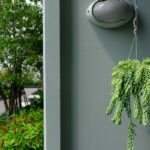Monstera is a genus of popular houseplants that are known for their resilient nature, easy maintenance requirements, and attractive appearance.

These houseplants notoriously grow large leaves and to tall heights, making them a fabulous addition to any room in a home.
While Monstera plants thrive in bedrooms and living rooms, the lines seem to blur when it comes to growing these plants elsewhere. Can Monstera live outside?
Surely, if Monstera naturally grows outdoors in South and Central American jungles, then you can grow one in your backyard?
Here is everything you need to know about whether Monstera can live outside!
Can Monstera Live Outside?
Unfortunately, there is no simple answer to this question. Monstera plants can technically live outside in USDA hardiness zones 10-12 throughout the year.
For any other hardiness zones, Monstera must be taken indoors during winter. This is because Monstera are known to die when the temperature drops below 60 °F.
As with all plants, the key to growing a Monstera (inside or outside) is to replicate their natural habitat as closely as possible. While Monstera are fairly hardy to most indoor environments and often thrive under neglect, the same cannot be said for outdoor conditions.
Monstera Natural Habitat
The natural habitat of Monstera is the jungles of South and Central America. They typically prefer to live in tropical regions, but can withstand sub-tropical conditions.
These rainforests are sparsely lit and very humid, which is why Monstera don’t like exposure to direct sunlight nor dry conditions (though they are drought-resistant when grown indoors).
It’s not always easy to mimic these conditions if your backyard isn’t in a tropical climate. In their natural habitat, Monstera feed off the fallen leaves, stems, and fruit of the taller surrounding trees, making for rich organic soil that cannot easily be replicated in a backyard.
However, due to this rich organic matter, Monstera are known to grow up to (and even over) 60 feet tall, which is why they’re often considered an invasive species in the wild.
So, while you might not be able to replicate the exact conditions in your backyard, that might be for good reason!
How To Grow Monstera Outside
The main rule to follow when growing Monstera outside is to know what USDA hardiness zone your home is in.
Monstera cannot survive in temperatures under 60 °F, which means you will have to relocate your Monstera inside if your backyard drops below that temperature in winter. If not, you can keep it outside year-round.
How To Acclimate Monstera

If you want to move your indoor Monstera to your backyard, you will need to properly acclimate it. To acclimatize something is to provide it with a peaceful transition into a new environment or situation.
Without proper acclimation, you run the risk of the Monstera leaves burning under the stronger sunlight, resulting in brown and unfixable crispy leaves.
The best way to acclimate Monstera is to leave your Monstera outside for a few hours a day. Try not to choose bright, sunny days, as this can scorch the plant immediately.
Leave it outside for a few hours on cloudy days, or put the plant in the shade. Eventually, you can start to increase the time left outside by an hour or so over the course of 2-3 weeks.
There is still a risk of the leaves burning during the acclimatization process, so if you notice the leaves turning brown, immediately take the plant indoors.
Some Monstera will need longer to transition to the outdoors than others. This might even be a sign that your Monstera isn’t happy to grow outside.
Sunlight
Once you have successfully acclimated your Monstera, then you need to find the right place for it outside. Monstera receives sparse amounts of sunlight in its natural habitat, which means these plants need to avoid direct sunlight.
Even acclimated Monstera plants will burn from too much sunlight exposure.
The best place to keep a Monstera is somewhere that keeps it in the shade during the midday rays, which is when the sunlight is strongest. Morning and evening sunlight is fine for Monstera.
However, it is recommended that you avoid putting variegated Monstera outside, as these plants will burn more easily. Alternatively, keep it in permanent shade.
Watering
While Monstera can go a week or two without watering indoors, the rules change for outdoor growth. Monstera plants grown outside receive more sunlight (even when it’s indirect) than when grown indoors, which means they need more water. In the heat of summer, this can increase to once or even twice a day.
You should check the soil as you normally would for an indoor Monstera. Stick your finger an inch into the soil, and if it’s completely dry, then water the plant.
Make sure to avoid getting water on the leaves, because this will result in scorching. If you live in dry conditions, you’ll need to mist your outdoor Monstera regularly to create a humid environment.
As always, try not to overwater your outdoor Monstera as this can lead to root rot. However, here’s where it gets tricky, because you can’t prevent rain.
Rain is a leading cause of root rot in outdoor Monstera, so it’s vital to provide your Monstera with a brilliant drainage system. This includes well-draining soil, drainage holes in the pot, and even lifting the pot so it doesn’t risk flooding.
Pests
Any plant grown outdoors is more susceptible to pests and insects. Unfortunately, there is no prevention for this, so you’ll need to commit to checking the plant daily. If you notice any signs of pests, you’ll need to quarantine the plant to prevent spreading the infestation.
Then, you can remove the infestation as you normally would for an indoor plant. This typically includes regularly washing the plant with water and rubbing the leaves with rubbing alcohol, neem oil, or a mixture of water and dish soap.
Luckily, Monstera are pretty hardy when it comes to battling pests as long as you treat the pests early enough.
Conclusion
Technically speaking, you can grow Monstera outside. However, it’s important to follow the new specific care requirements for a Monstera living in your backyard.
While they are hardy plants, the new exposure to the elements can lead to deterioration rather quickly.
- Best Hanging Plant For Low Light - September 4, 2023
- Best Indoor Plants Florida - August 28, 2023
- Best Plants For Bathroom Smells - August 21, 2023








